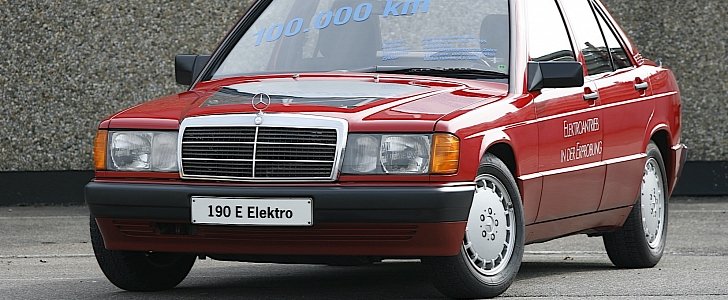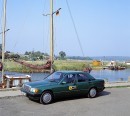In the world of electric car makers, present-day Mercedes-Benz can be considered a late bloomer. It wasn’t until the 2016 Paris Motor Show when the carmaker defined in a clearer way its electric car strategy, and the world had to wait for three more years before the brand’s first fully-electric vehicle for the market was introduced.
That car is the EQC, the first in the EQ family that since 2019 grew to include the EQV and EQB – and more are on the way. But Mercedes was toying with the idea of an electric drive long ago, as far back as the 1990s.
Back then, the carmaker showed at several shows across the world, starting with the Hanover Fair in 1990, electric variants of the 190 (W201). They were crude machines, far less advanced than what we have today, and they can’t even be considered a precursor of any existing electric model, but they did exist.
The first variants of the electric 190s used several electric drivetrains, based on high-energy, dangerous batteries that used sodium-nickel chloride or sodium-sulphur, which got their energy including from solar-powered recharging stations.
The range on those cars was of course not great, despite the available regenerative braking, and power sat at just 44 hp, equally split between two permanent magnet DC motors fitted on each of the rear wheels.
In the end, nothing came of these cars, and Mercedes buried itself in other projects for decades, including some involving hydrogen power. It wasn’t until others, spearheaded by Tesla, that Mercedes came back on electric drivetrains.
With nothing else more interesting to talk about during these days of near global lockdown, Mercedes-Benz tries to explain why it wasn’t the first to market an electric car. And it all boils down to the tech available at the time.
“The question remains as to why electric vehicles are only now becoming established and why they did not take off on the basis of the projects of that time,” the carmaker said.
“Battery service life, range, recycling, charging infrastructure and vehicle price are quoted as just some of the keywords in a Mercedes-Benz press release from spring 1991 as challenges faced by e-mobility on the way to series production."
Back then, the carmaker showed at several shows across the world, starting with the Hanover Fair in 1990, electric variants of the 190 (W201). They were crude machines, far less advanced than what we have today, and they can’t even be considered a precursor of any existing electric model, but they did exist.
The first variants of the electric 190s used several electric drivetrains, based on high-energy, dangerous batteries that used sodium-nickel chloride or sodium-sulphur, which got their energy including from solar-powered recharging stations.
The range on those cars was of course not great, despite the available regenerative braking, and power sat at just 44 hp, equally split between two permanent magnet DC motors fitted on each of the rear wheels.
In the end, nothing came of these cars, and Mercedes buried itself in other projects for decades, including some involving hydrogen power. It wasn’t until others, spearheaded by Tesla, that Mercedes came back on electric drivetrains.
With nothing else more interesting to talk about during these days of near global lockdown, Mercedes-Benz tries to explain why it wasn’t the first to market an electric car. And it all boils down to the tech available at the time.
“The question remains as to why electric vehicles are only now becoming established and why they did not take off on the basis of the projects of that time,” the carmaker said.
“Battery service life, range, recycling, charging infrastructure and vehicle price are quoted as just some of the keywords in a Mercedes-Benz press release from spring 1991 as challenges faced by e-mobility on the way to series production."








